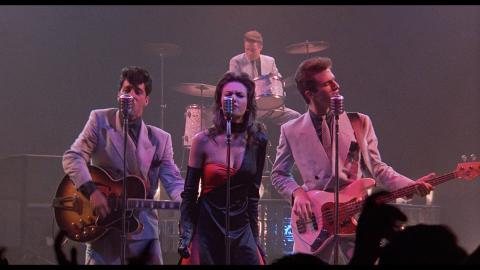STREETS OF FIRE: Another Time, Another Place

STREETS OF FIRE
The following notes on Streets of Fire were written by David Vanden Bossche, PhD Candidate in the department of Communication Arts at UW Madison. A 35mm print of Streets of Fire will screen on Friday, April 26 at 7 p.m. in the Cinematheque's regular venue, 4070 Vilas Hall, 821 University Ave. Admission is free!
By David Vanden Bossche
“My name’s John Ford, I make westerns” is a somewhat self-effacing quote from one of Hollywood’s great filmmakers, but the sentiment is equally true of Walter Hill, the underrated genre specialist behind such films as The Long Riders (1980), Geronimo: An American Legend (1993), Last Man Standing (1996) and the recent but mostly unseen Budd Boetticher homage Dead for a Dollar (2022). Hill, much like his progenitors Ford and Howard Hawks, has made several genuine westerns, but in a way every film Hill ever made is a western in some form or fashion. Films such as The Warriors (1979), Southern Comfort (1981), and Trespass (1992) wear their Western influence on their sleeve, but among the most interesting and most accomplished of Hill’s pseudo-Westerns is Streets of Fire, one of the great forgotten movies of the 1980s.
Coming off the success of the Eddie Murphy/Nick Nolte buddy cop film 48 Hrs., Hill and screenwriter Larry Gross quickly set out to build on the momentum and get another production greenlit. Presented as a “Rock ‘n Roll Fable” the movie took its title from the Bruce Springsteen song featured on 1978’s Darkness on the Edge of Town album (negotiations with Springsteen failed and the song did not end up making it onto the soundtrack) and was set up from the start as an action movie/musical hybrid. Famed composer and frequent Meat Loaf collaborator Jim Steinman stepped in to write a pair of songs that bookend the film and the rest of the soundtrack prominently features rock and blues material alongside an instrumental score by longtime Hill collaborator Ry Cooder.
The storyline basically recycles a formula from several early westerns in which the hero must venture into hostile territory to rescue a kidnapped woman. In this case, the ‘damsel in distress’ is singer Ellen Aim (Diane Lane, in a portrayal clearly inspired by rocker Joan Jett), the ex-sweetheart of ex-soldier Tom Cody (Michael Paré). All we learn about Cody is a cryptic “went to war, liked the shooting, didn’t like the medals” but in true western ‘man with no name’ tradition, the real introduction comes when—in a clear nod to Sam Peckinpah’s The Wild Bunch (1969)—Cody chases down and manhandles a gang of retrofuturistic greasers from his sister’s bar. Returning to his hometown for the first time in years, Cody enlists the help of a tough female companion (Amy Madigan) and Ellen’s boyfriend-manager Billy Fish (Rick Moranis, playing against his normal nerd persona) to rescue his former love from the clutches of the villain Raven, played with maniacal glee by Willem Dafoe in one of his first major screen appearances.
A nostalgic fifties aesthetic accentuated with futuristic neon and dystopian fire defines the one-of-a-kind visual style. True to its opening line “Another Time, Another Place”, Streets of Fire presents a landscape and era that only exists in movies. Filmed in Los Angeles and Chicago, the film offers some recognizable geographic elements but unlike the gritty crime thrillers of the 1970s in which the location took center stage—films such as Dirty Harry and The French Connection—Streets of Fire is part of the 80s trend that turned urban landscapes into ever more abstract and artificial entities, eschewing the more ‘anchored’ approach of the previous decade. Photographed by famed DP Andrew Laszlo, with whom Hill had previously worked on The Warriors and Southern Comfort, Streets of Fire is—as Belgian film critic Patrick Duynslaegher described it at the time—“a furious ballet of chases, cars, motorcycles, embraces in the photogenically pouring rain, fires in the night, sweaty torsos in torn T-shirts and symbols of the noir tradition.” With its daring use of colored filters and extreme contrasts making the most of the features and latitude of Eastman’s 250T 5293 stock that had been released only two years prior, Hill’s movie was part of what film historian Katrina Glitre called the “neon rainbow” cinematography of the 1980s. This trend brought back the extreme visual mannerism of 1940s ‘noir’ cinema, this time in color, thus heralding the advent of ‘neo-noir’ in films like Body Heat (1982) and Blade Runner (1982).
A final nod to the editing that Hill supervised with Freeman Davies, another longtime collaborator. Taking cues from the contemporaneous MTV music video style, the editing team on Streets of Fire delivered some razor-sharp, rhythmic cutting. If one scene stands out, it has to be the dreamy walk through abstractly lit neon-drenched streets cued to the music of Marylin Martin’s “Sorcerer,” a filmic moment that produces an almost hallucinogenic quality by interspersing the cuts with brief fades to black.
Alas, none of the film’s qualities translated into box office success. Despite a successful soundtrack and a theatrical run that included several 70mm engagements, the film barely made back half of its budget in its initial release. Luckily for Hill, the movie has had quite an afterlife on the home video market—including a recent 4K restoration from Shout! Factory—and has slowly grown into something of a cult classic. In reaction to my statement that Streets of Fire was my favorite among his movies, Hill himself disgruntledly asked “then where was everyone in 1984?” during an interview I had with the director in the 1990s. Where, indeed.
